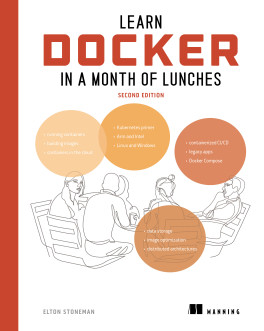pro $24.99 per month
- access to all Manning books, MEAPs, liveVideos, liveProjects, and audiobooks!
- choose one free eBook per month to keep
- exclusive 50% discount on all purchases
- renews monthly, pause or cancel renewal anytime
lite $19.99 per month
- access to all Manning books, including MEAPs!
team
5, 10 or 20 seats+ for your team - learn more

Docker in Practice, Second Edition presents over 100 practical techniques, hand-picked to help you get the most out of Docker. Following a Problem/Solution/Discussion format, you'll walk through specific examples that you can use immediately, and you'll get expert guidance on techniques that you can apply to a whole range of scenarios.
about the technology
Docker’s simple idea—wrapping an application and its dependencies into a single deployable container—created a buzz in the software industry. Now, containers are essential to enterprise infrastructure, and Docker is the undisputed industry standard. So what do you do after you’ve mastered the basics? To really streamline your applications and transform your dev process, you need relevant examples and experts who can walk you through them. You need this book.
about the book
Docker in Practice, Second Edition teaches you rock-solid, tested Docker techniques, such as replacing VMs, enabling microservices architecture, efficient network modeling, offline productivity, and establishing a container-driven continuous delivery process. Following a cookbook-style problem/solution format, you’ll explore real-world use cases and learn how to apply the lessons to your own dev projects.
what's inside
- Continuous integration and delivery
- The Kubernetes orchestration tool
- Streamlining your cloud workflow
- Docker in swarm mode
- Emerging best practices and techniques
Must-have guide to understanding, setting up, and administering Docker! The authors do a fantastic job identifying and resolving common problems.
Docker took the software industry by storm, and this book is what you need to best navigate those stormy waters.
Not just a Docker book—it also makes you an effective DevOps person by teaching how to use the command line better.
An excellent Docker playbook, curated from hard-won experience in the field. Your Docker knowledge will be greatly expanded.
Updated as Docker has evolved, this book is an essential guide with excellent working examples. Keep your skills fresh!
The first book you should read after Docker's own Getting Started pages!
team
- five seats for your team
- access to all Manning books, MEAPs, liveVideos, liveProjects, and audiobooks!
- choose another free product every time you renew
- choose twelve free products per year
- exclusive 50% discount on all purchases
- renews monthly, pause or cancel renewal anytime
- renews annually, pause or cancel renewal anytime
-
![]() Docker in Practice, Second Edition ebook for free
Docker in Practice, Second Edition ebook for free
team
- five seats for your team
- access to all Manning books, MEAPs, liveVideos, liveProjects, and audiobooks!
- choose another free product every time you renew
- choose twelve free products per year
- exclusive 50% discount on all purchases
- renews monthly, pause or cancel renewal anytime
- renews annually, pause or cancel renewal anytime
-
![]() Docker in Practice, Second Edition ebook for free
Docker in Practice, Second Edition ebook for free














 Docker in Practice, Second Edition ebook for free
Docker in Practice, Second Edition ebook for free